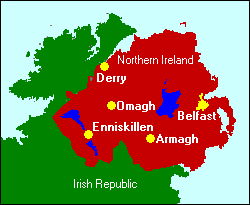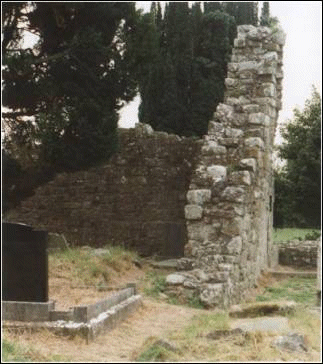
Introduction
The purpose of this Web site is to outline the history of County Fermanagh and in particular, the story of the most important of Fermanagh's Gaelic clans - the Maguire family. Our story traces the history of the clan from its beginnings right up to the present day.

Clan
Maguire first came to prominence in Fermanagh in the middle of the 12th century
and eventually fell from power with the arrival of the English during the Elizabethan
conquest of Ulster in the early part of the 17th century. During the subsequent
'Plantation' period, Ulster saw the arrival of English and
Scottish settlers whose successors helped to fashion a new generation of
Fermanagh people and gave the county new ideas, beliefs, customs and a new
language spoken with a distinctive accent.
The
modern county is an integral part of the ancient Irish province of Ulster, and
derives its name from the clan Fir Manach,
meaning the "Men of Manach". Five hundred years before the little kingdom of
Fermanagh was formed, the Celts reached westward from their origins in southern
Germany. These tall, clean-shaven warriors expanded into the Iberian Peninsula
and moved steadily westwards until they reached the shores of Ireland. The Celts
quickly established themselves and began to take control of the whole country.
By
the birth of Christ, only the northern Irish province of Ulster was not under
the control of these brave and hospitable people. When Ulster threatened the
whole country, the province of Connacht in the west led the defence and in later
years, pushed northwards and eastwards eventually bringing the northern province
under Celtic control. By the fifth century AD, the most powerful of the northern
clans - the O'Neills - were the dominant authority in Ulster.
The
fifth century brought great political changes to Ireland, particularly to the
northern province of Ulster. This transformation brought with it something that
has remained solidly with Ulster people to the present day - Christianity.
Most people know of the conversion of the island by St. Patrick who arrived from
mainland Britain in 432 AD. Twenty years later, Patrick made Armagh his
headquarters and introduced mainstream Latin Christianity to Ireland for the
first time. This structure of Bishops with dioceses was modelled on the system
used by the Roman Empire but did not take firm root in Ireland. Instead, a
monastic arrangement developed with great autonomous monasteries, each under the
control of an abbot, providing the focal point for Celtic Christianity.
Fermanagh was no exception and the monastery on Devenish Island in Lough Erne
with its 80 foot round tower became part of this "Golden Age" when these
great monastic centres of learning sent out missionaries to the rest of Europe,
already caught in the Dark Ages. Devenish Island and its ruins still survive
today and has become Fermanagh's greatest landmark.
 |
|
The ruins of Aghalurcher Church |
Though
there are many stories about St. Patrick's missions to Fermanagh, it is not
certain if he ever actually visited the Erne country. The foot soldiers of the
new faith were probably recruited from local clans and indeed these early saints
made a lasting impression on Fermanagh and its people. One of these
missionaries, Saint Ronan, came to south Fermanagh and established a church near
the modern town of Lisnaskea in what is now the townland of Aghalurcher. A local
legend tells us that the people of the locality could not agree on where the new
church should be built so to resolve the issue they decided to cast a stone and
where the stone landed, the new church would be built. This gave the area the
name "Achadh Urchair" meaning in English "the field of the cast". The
tiny church has stood the test of time and its ruins and ancient cemetery still
survive to the present day.
When
Ireland eventually settled into a Christian and Celtic way of life the island
saw the establishment of a federal monarchy in which the Ard Ri or High King of Ireland sat at the top of
the hierarchy. Each of the four provinces of Ulster, Munster, Leinster and
Connacht was made up of a collection of independent kingdoms called
tuaths. Fermanagh contained at least seven tuaths and its chieftains
were sometimes referred to as "Lord of the Seven Tuaths". A
leader called a Taoiseach,
elected by the freemen of the tuath, controlled everything and presided over the
assembly known as a Dail.
The Taoiseach, who had to be a member of the
Deirfine (Royal Family), acted as chieftain, judge and commander-in-chief. This
federal monarchy symbolised the unity of the country though the powers
exercised downwards were not impressive.
The
autonomous tuath became the basic unit of Celtic secular society with the
Taoiseach as chieftain, the nobility, bardic class and clergy below this level
and the common people at the bottom of the social strata. Part of the bardic
class structure was the Brehon or judge who dealt with grievances and disputes within the
kingdom. Celtic society was far more protective of the rights of the commoner
than other parallel European cultures of the period.
The
Brehon laws were an immensely complex legal system that functioned in Ireland
for a period of at least 1000 years until the middle of the 17th century.
These laws respected individuals first and property second. They honoured the
sanctity of contract. Women had equal rights to men and all citizens owed a duty
of hospitality to strangers. Incredibly, this legal system needed no court to
enforce the law since all citizens respected it.
The
Bardic schools, which were separate from the ecclesiastical schools sponsored by
the great monasteries of Ireland, trained young men in history, law, language
and literature. From these schools, the poets, historians, brehons and
physicians graduated. All members of the bardic classes were entitled to special
privileges. An example of this would be the right of entry to any home in the
kingdom, the hospitality of the host and free food and shelter. The bardic
classes did not take any active part in battle but only offered advice to their
leader and recorded the events for posterity.
The
post of Brehon became recognised as a professional position in Irish society
during the early Christian period. These educated intellectuals were specialists
who knew and developed ancient Irish law. Disputes and difficulties were
referred to them and decisions were usually accepted as binding. The Brehon
declared what the law stated as applied to the facts brought before him and
acted more as an arbitrator than a judge. In Celtic Fermanagh of the Maguire
period, the Brehons were recruited from the O Breaslain (Breslin)
family. This tradition continued in Fermanagh until 1603 when the last Breslin
Brehon handed over the ancient scrolls to Sir John Davys, the English
Attorney-General on Devenish Island in Lough Erne.